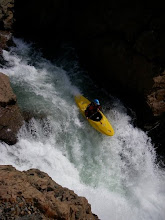Every year when the seasons change, and Fall rolls around, I start thinking about a paddling vacation. Some years it's BC, others it's California....

This year was Oregon. Plan A was Canada, eh, while Plan B was the 11 friends, 2 rafts and a pirate party on the Rogue River. Plan A fell through a week before D-day, and Plan B sounded like a pretty rad option, so we said yes, and had ourselves a little 3-day, 2-night vacation on the Wild and Scenic Rogue River from Graves Creek to Foster Bar.

This section of the Rogue River is known for it's history (mining and homsteading), black bears, and mountainous terrain. Not to mention beautiful scenery and quality rapids such as Rainie Falls and Blossom Bar.

Our group exploring Zane Grey's Cabin

Zane Grey's Cabin
With a forecast for three very rainy days, eleven of us, including trip leader, Kate Wagner, and Birthday-Girl, Rachel Crowder launched Sunday morning from Graves Creek, making camp at Battle Bar, 16 miles downstream.

The crew below the put-in: Kevin, Kate, and I

Scouting Rainie Falls, 'proper'

Joe Stumpfel in his Wave Hopper, and the rest of the crew

Kelsey Lake

Keeping with Southern Oregon tradition, we brought pumpkins with us on the river.

and placed them in obscure spots along the river... such as this one.

Battle Bar

Shelter for the night
Day 2: After a very rainy night, we woke up and had a pancake and sausage feast - Breakfast of Champions! After a quick stop at Zane Grey's Cabin, we were off to paddle 12 miles from Battle Bar through Mule Creek Canyon, and bigger rapids such as Coffeepot, and Blossom Bar to Lower Solitude, our camp for day 2.

Kevin, Joe Stumpfel, Bryon Dorr, and Shalynn

Mule Creek Canyon

Waterfall in Mule Creek Canyon

Blossom Bar

Myself at Blossom Bar

Party on the River!

Lower Solitude Camp - Bocce Ball and Pirate Party
Day 3: Our last day on the river, we had about 7 miles till the takeout at Foster Bar. It was decided to take our time getting to the takeout, and make a pit stop here and there along the way to check out nearby waterfalls and water slides.

Flora Dell Falls

At 1:30pm, we rolled into Foster Bar, our take-out. What a great 3 days on the river! Between rain showers, we broke down the rafts, and made quick work of the drive home to Hood River.
Happy early-Halloween!
Kim Russell








